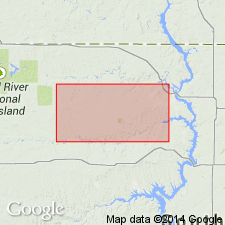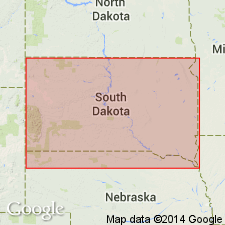
- Usage in publication:
-
- Timber Lake sandstone member
- Modifications:
-
- Named
- Dominant lithology:
-
- Sandstone
- Claystone
- AAPG geologic province:
-
- Williston basin
Summary:
Named as a member of Fox Hills Formation (redescribed) for exposures in a near town of Timber Lake, Dewey Co, SD in the Williston basin. No type locality designated. Many buttes are capped by this member, especially those where the member is case-hardened or indurated. Overlies the Trail City member (new) of the Fox Hills. Underlies the banded beds of the Fox Hills. Divisible into two parts. The lower part is a greenish-yellow quartz, soft uncemented sandstone. The upper part consists of calcareous, lens-shaped, concretionary masses in thin bands of fine-grained, orange to brown, well-cemented limonite claystone and mottled sandstone. Is about 90 ft thick. In the upper part, the cement is calcite, and the concretionary masses weather as brownish ledges. The sand between the ledges is often marked or mottled. Assigned to the Late Cretaceous. Columnar section.
Source: GNU records (USGS DDS-6; Denver GNULEX).

- Usage in publication:
-
- Timber Lake Member
- Modifications:
-
- Principal reference
- Revised
- Biostratigraphic dating
- Dominant lithology:
-
- Sandstone
- Silt
- Clay
- AAPG geologic province:
-
- Williston basin
Summary:
Is a name applied to the middle member of Upper Cretaceous Fox Hills Formation. Previously thought to be a continuous unit in area of Fox Hills outcrop. Disappears by facies change in west part of area where it grades into the upper part of Irish Creek lithofacies (new), the western lithofacies of Trail City Member of Fox Hills. Intertongues with and underlies the Iron Lightning Member (new) of Fox Hills. In east part of area, Timber Lake overlies Little Eagle lithofacies (new), eastern lithofacies of Trail City. Crops out in gully and valley walls, road cuts, on sides of buttes and bluffs. Present in few exposures. Maximum measured thickness 150 ft but that did not include the upper part. Described as a yellow to yellow-orange, very fine to medium grained, poorly consolidated sandstone with varying amounts of silt and clay. Has local beds of clean current-washed sandstone. Consists of feldspar and quartz in equal amounts. Sorting is variable. Pyrite is an ubiquitous secondary mineral. Jarosite layer at base. Compositionally it is a subgraywacke. Cross-stratification features common. Cross sections; nomenclature chart; geologic map; facies map; measured sections. Principal reference section 145 ft thick measured at NE1/4 SW1/4 sec 27, T15N, R23E, Dewey Co. Fossil mollusks: CUCULLAEA and CYMBOPHORA-TELLINA Assemblage zones. Of Late Cretaceous, Maestrichtian age.
Source: GNU records (USGS DDS-6; Denver GNULEX).
For more information, please contact Nancy Stamm, Geologic Names Committee Secretary.
Asterisk (*) indicates published by U.S. Geological Survey authors.
"No current usage" (†) implies that a name has been abandoned or has fallen into disuse. Former usage and, if known, replacement name given in parentheses ( ).
Slash (/) indicates name conflicts with nomenclatural guidelines (CSN, 1933; ACSN, 1961, 1970; NACSN, 1983, 2005, 2021). May be explained within brackets ([ ]).

